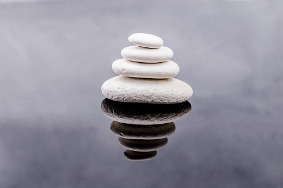This page gives you information about mindfulness for your health and well-being, as well as some foundational activities to strengthen your daily Mindfulness practice. It includes the following sections:
1. The health benefits of mindfulness.
2. What is mindfulness?
3. Practising mindfulness regularly.
4. Learning to practice mindfulness resources.
5. A mindfulness exercise called “using the ten-breaths”.

1. The health benefits of Mindfulness
There is so much research out there now, on this topic. It’s been scientifically proven (the research references are at the bottom of the page) that mindfulness can:
- Slow down ageing.
- Increase happiness.
- Improve brain function.
- Enhance mental health.
- Regulate emotions.
- Improve decision making.
- Increase perception.
- Give relaxation.
- Reduce the risk of cardiovascular disease.
- Be highly effective in pain management.
These long term benefits don’t come immediately – you need to practise mindfulness regularly. And also, in the context of stress and emotional distress, mindfulness is not an easy skill to learn.
But you can start with just a little each day.
2. What is Mindfulness?
 Mindfulness has been defined as “paying attention in a particular way: on purpose, in the present moment, and nonjudgementally” (Kabat-Zinn 1994 p.4). One way of exploring the concept of Mindfulness is to understand it as an active state of being. Mindfulness is being aware, being non judgemental, being accepting of what one is experiencing, and being present, all within the current moment (Keng, Smoski and Robins 2011).
Mindfulness has been defined as “paying attention in a particular way: on purpose, in the present moment, and nonjudgementally” (Kabat-Zinn 1994 p.4). One way of exploring the concept of Mindfulness is to understand it as an active state of being. Mindfulness is being aware, being non judgemental, being accepting of what one is experiencing, and being present, all within the current moment (Keng, Smoski and Robins 2011).
So the links at the bottom of this page give some good resources for you to try, to help you learn mindfulness.
3. Practising Mindfulness regularly.
To get the long term health benefits from mindfulness, like any other health practice, doing small daily practise is the key. It takes time to build up your stamina with mindfulness and focus the mind so that you can be mindful.
Practising mindfulness can be as challenging as the training is for any sport. So starting small, daily practice is the way to begin.
4. Learning to practise Mindfulness resources
These resources are foundation level exercises in learning to practise mindfulness. They are recordings which guide you in each of the mindfulness activities.
You can do these activities in the morning, afternoon or evening, as a little “mini relax break”, a little “quality time out” for yourself.
In all the mindfulness activities, treat your body and mind kindly and lovingly. Be gentle with yourself, your mind and your body. Please don’t mentally or physically strain in any of the exercises. And you can always breathe in and let go – this is taking in a deep breath, slowly exhaling, and at the same time giving whatever you are carrying in that moment to the ground. The ground is used to carrying everything, including you, and can carry anything you give it 🙂
Below are a seven audio recordings of Mindfulness exercises.
Please click on the links below the image to access the activities.

Progressive muscle relaxation and mindfulness. These are introductory activities designed to relax areas in your body.
1.Sitting on a chair. 8 minutes. This is a chair based relaxation activity. Find a quiet space, sit comfortably in a chair. Click on link, and follow the instructions here: Progressive muscle relaxation 1
2.Sitting on chair, or lying on the bed. 5 minutes. This activity focuses upon the use of breath in the progressive muscle relaxation meditation. Click on the link here: Breath focused progressive muscle relaxation 2

Relaxed breathing exercises. These are introductory activities designed to focus upon the breath. These are helpful foundations in learning to practise mindfulness.
3.Relaxed breathing. 2 minutes. Click on the link here for the activity: Relaxed breathing 1
4. Deep breathing. 4 minutes. Click on the link here for the activity: Deep breathing 1

Guided Mindfulness. These activities help you to relax through the use of evoking imagery for you to interact with whilst you are breathing.
5.Ocean Waves. 9 minutes. Click on the link here for the activity: Ocean Waves
6. Oak Creek. 9 minutes. Click on the link here for the activity: Oak Creek
7. Mountain Top. 6 minutes. Click on the link here for the activity: Mountain Top
5. Mindfulness Exercise.
Here’s a mindfulness exercise called “using the ten-breaths”.

Work through the points below.
Using the ten-breaths.
1. TAKE THE SITTING POSTURE: I sit on a chair that supports me in an upright position. I lean forward slightly so my feet are on the floor, and if I wanted to I could get up from the chair from this position.
2.BRING YOUR FOCUS INWARDS TO THE BODY: I begin to tune out the exterior noises, and put my focus on the feel of my feet on the floor. I can choose to keep my eyes open or closed, whatever suits me best, but my focus is inward and on my breath. My hands are on my lap, or resting easily on the top of my legs. I let go of my shoulders ( I tell myself, “I let go of my shoulders”).
3. NOTICE AND RELEASE ANY TENSE BODY AREAS: I feel my body in this sitting posture and relax any tensions I notice. I start to take some longer and deeper breaths, in through the nose and out through the mouth, or whatever is most comfortable for me. I focus on my feet, and notice the sensation of them. I keep their contact with the floor, keeping a good sitting position, in the sense that if I wanted to I can stand up from the seated position I am in. I continue to breathe, keeping my focus on my feet. If any tensions come up in other areas of the body whilst I am doing this, I tell myself, ” I let go of… whatever area of the body is feeling tense”. And then I move my focus back to my feet.
4. BREATHE SLOWLY IN AND OUT, NOTICING THE ABDOMEN MOVEMENT: I comfortably and slowly breathe in a long breath, noticing and feeling the moment in my abdomen as I do this. I then let the breath slowly out, again noticing and feeling the movement in my abdomen. I do this for TEN BREATHS. In through the nose, and out through the mouth, or whatever is comfortable for me. I count each of these slow breaths to myself, from one to ten. Any thoughts I have I let them pass over me, and I bring my focus always back to firstly my feet and the sensation of the floor, then to my breathing, and finally to my abdomen movement again.
5. SLOWLY COME BACK TO YOUR DAILY AWARENESS OF THE OUTSIDE WORLD: After I have completed my tenth breath in and out, I slowly and gently begin to bring my focus to the noises around me, and the external world. I bring myself back into my daily world.
To deepen this activity. Work through each of the sections in the activity (like in learning new dance steps, or tai chi movements, and ensure you are working from an ACTIVE sitting position) so you know what you are doing. Active means that you could press down on the floor and get up from the chair, you are not slumping backwards. In your mind, this type of activity is an active stance – you are awake and focusing on what you are doing. Like resting in a refreshing stream that bubbles up through your feet. You can press your feet down onto the floor during the activity, to help remember this, visualising the stream bubbling up through you.
Take yourself through this activity a number of times. Then make a recording of the instructions using your own voice TO SUIT YOUR OWN BREATHING RHYTHM AND PACE. Use a calm, caring and slow voice tone for the recording, leaving spaces that follow the rhythm of your own breathing.
Doing a recording ensures that the activity matches your pace, and also enables you to practise the use of your own voice on the impact of your stress, listening to your own “self-talk”. Furthermore, emerging research posits that there is a link between the voice and stress, with pace and tone being mediators, which has the potential for us to consciously utilise our voice in our own stress management (Puyvelde et al. 2018).
Living your life mindfully

Living your life mindfully means:
being aware;
being non judgemental;
being accepting of what one is experiencing;
and being present,
all within the current moment.
REFERENCES:
Baijal, S. & Srinivasan, N. 2009. Theta activity and meditative states: spectral changes during concentrative meditation. Cognitive Processing, 11(1):31–38. doi: 10.1007/s10339-009-0272-0 PMID: 19626355
Fox, K.C.R., Nijeboer, S., Dixon, M., Floman, J.L., Ellamil, M., Rumak, S.P., et al. 2014. Is meditation associated with
altered brain structure? A systematic review and meta-analysis of morphometric neuroimaging in meditation practitioners. Neuroscience & Biobehavioral Reviews, 43:48–73. doi: 10.1016/j.neubiorev.2014.03.016 PMID: 24705269
Hoelzel, B.K,, Carmody, J., Vangel, M., Congleton, C., Yerramsetti, S.M., Gard, T., et al. 2011. Mindfulness practice
leads to increases in regional brain gray matter density. Psychiatry Research: Neuroimaging, 191(1):36–43. doi: 10.1016/j.pscychresns.2010.08.006 PMID: 21071182
Kerr, C.E., Jones, S.R., Wan, Q., Pritchett, D.L., Wasserman, R.H., Wexler, A., et al. 2011.Effects of mindfulness meditation training on anticipatory alpha modulation in primary somatosensory cortex. Brain Research Bulletin, 85(3–4):96–103. doi: 10.1016/j.brainresbull.2011.03.026 PMID: 21501665
Kerr, C.E., Sacchet, M.D., Lazar, S.W., Moore, C.I. & Jones, S.R. 2013. Mindfulness starts with the body: somatosensory attention and top-down modulation of cortical alpha rhythms in mindfulness meditation. Frontiers in Human Neuroscience, 7:12. doi: 10.3389/fnhum.2013.00012 PMID: 23408771
Luders, E., Phillips, O.R., Clark, K., Kurth, F., Toga, A.W. & Narr, K.L. 2012. Bridging the hemispheres in meditation:Thicker callosal regions and enhanced fractional anisotropy (FA) in long-term practitioners. Neuro-Image, 61(1):181–187. doi: 10.1016/j.neuroimage.2012.02.026 PMID: 22374478
Orme-Johnson, D.W., Schneider, R.H., Son, Y.D., Nidich, S. & Cho, Z.H. 2006. Neuroimaging of meditation’s effect on
brain reactivity to pain. NeuroReport, 17(12):1359–1363. doi: 10.1097/01.wnr.0000233094.67289.a8 PMID: 16951585
Pagnoni, G. & Ceki, M. 2007. Age effects on gray matter volume and attentional performance in Zen meditation.
Neurobiology of Aging, 28(10):1623–1627. doi: 10.1016/j.neurobiolaging.2007.06.008 PMID:17655980
Pagnoni, G. 2012.Dynamical Properties of BOLD Activity from the Ventral Posteromedial Cortex Associated with Meditation and Attentional Skills. Journal of Neuroscience, 32(15):5242–5249. doi: 10.1523/JNEUROSCI.4135-11.2012 PMID: 22496570
Puyvelde, M.V., Neyt, X., McGlone, F. and Pattyn, N. 2018. Voice Stress Analysis. A new framework for voice and effort in human performance. Front. Psychol. 9:1994. doi: 10.3389/fpsyg.2018.01994
Segal, Z.V., Bieling, P., Young, T., MacQueen, G., Cooke, R., Martin, L., et al. 2010. Antidepressant Monotherapy vs
Sequential Pharmacotherapy and Mindfulness-Based Cognitive Therapy, or Placebo, for Relapse Pro-phylaxis in Recurrent Depression. Archives of General Psychiatry, 67(12):1256–1264. doi: 10.1001/archgenpsychiatry.2010.168 PMID: 21135325
Tang, Y.Y,, Ma, Y., Wang, J., Fan, Y., Feng, S., Lu, Q., et al. 2007.Short-term meditation training improves attentionand self-regulation. Proceedings of the National Academy of Sciences, 104(43):17152–17156.doi: 10.1073/pnas.0707678104 PMID: 17940025
Travis, F. & Wallace, R.K. 1999. Autonomic and EEG Patterns during Eyes-Closed Rest and Transcendental Meditation (TM) Practice: The Basis for a Neural Model of TM Practice. Consciousness and Cognition.1999; 8(3):302–318. doi: 10.1006/ccog.1999.0403 PMID: 10487785